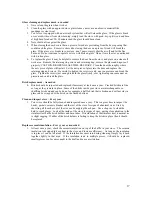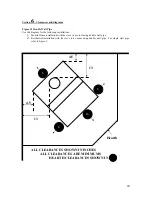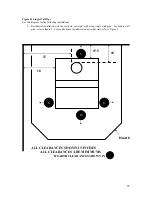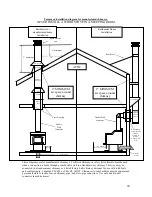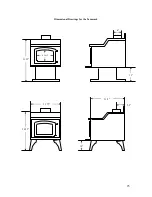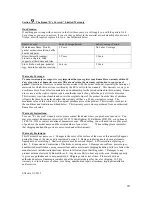
14
Additional instructions and information.
1.
Build your fires directly on the firebrick. Using a grate will allow too much air to the coal bed and
will result in incomplete combustion of the wood. Using a grate can also leave charred pieces of
wood after the fire has gone out
2.
Use only the best grade of dry wood available. Wood should be seasoned for 1 full year prior to
being used. Split wood will season much faster and better that wood left in the rounds. Burning
green or wet wood greatly increases the chance of creosote buildup and produces significantly less
heat.
The number 1 cause for creosote buildup is moisture in the wood.
Store your wood in a
dry location.
Any wood stored near the stove needs to maintain proper clearance from the stove.
3.
This heater is designed to burn natural wood only. Higher efficiencies and lower emissions
generally result when burning air dried seasoned hardwoods, as compared to softwoods or to green
or freshly cut hardwoods. DO NOT BURN:
a.
Garbage;
b.
Lawn clippings or yard waste;
c.
Materials containing rubber, including tires;
d.
Materials containing plastic;
e.
Waste petroleum products, paints or paint thinners, or asphalt products;
f.
Materials containing asbestos;
g.
Construction or demolition debris;
h.
Railroad ties or pressure-treated wood;
i.
Manure or animal remains;
j.
Salt water driftwood or other previously salt water saturated materials;
k.
Unseasoned wood; or
l.
Paper products, cardboard, plywood, or particleboard.
The prohibition against burning these materials does not prohibit the use of fire starters made
from paper, cardboard, saw dust, wax and similar substances for the purpose of starting a fire
in an affected wood heater. Burning these materials may result in release of toxic fumes or
render the heater ineffective and cause smoke.
4.
Small hot fires produce less creosote than long, low smoldering fires. When you start your stove
or are re-kindling (reloading) your wood stove with a full or sizeable load of wood, open the draft
fully and burn the stove at full burn for 20-30 minutes to heat up the chimney and secondary burn
system. This ensures that when the draft control is pushed back for a lower, longer burn, the stove
will burn cleaner. You should notice more upper firebox flame activity. This is smoke from the
wood mixing with pre-heated air and burning. This is called secondary burn and results in higher
stove temperature at lower burn rates and less soot and creosote build-up. Just after starting the
fire, some smoke may occur until the chimney warms up to produce some draft. During normal
operation, adjust the draft to the position required. If properly set, it will assure longest burn times
and the most even heat cycle. Larger loads of wood will create the longest burn times.
Optional blower operation instructions
To install the blower, follow the instructions packaged with the blower. Plug the blower into the nearest
115V grounded circuit. Turn the variable speed knob to ‘click’ onto high speed. As the knob is turned
clock-wise, the blower speed decreases to your desired speed. The blower speed should match the desired
burn rate on your stove: i.e. low-burn rate...low blower speed; high-burn rate… high blower speed and so
forth.
Ash Pan Operating Instructions:
Safety Precautions
1. Do not operate your wood stove with the ash pan open or removed.
2. Empty the ash pan when the fire is at its lowest point or out.
3. NEVER empty ashes into a combustible container (paper bag,
plastic bucket, etc.)
4. NEVER leave ashes in the house or garage. Ashes that seem to be

















